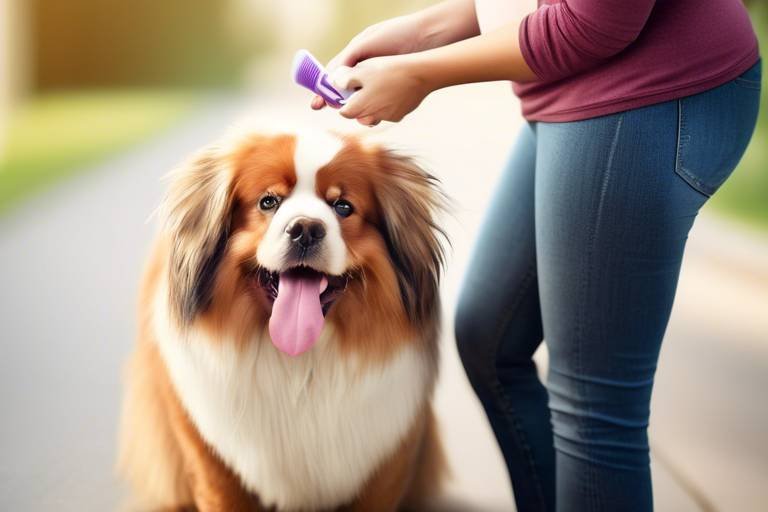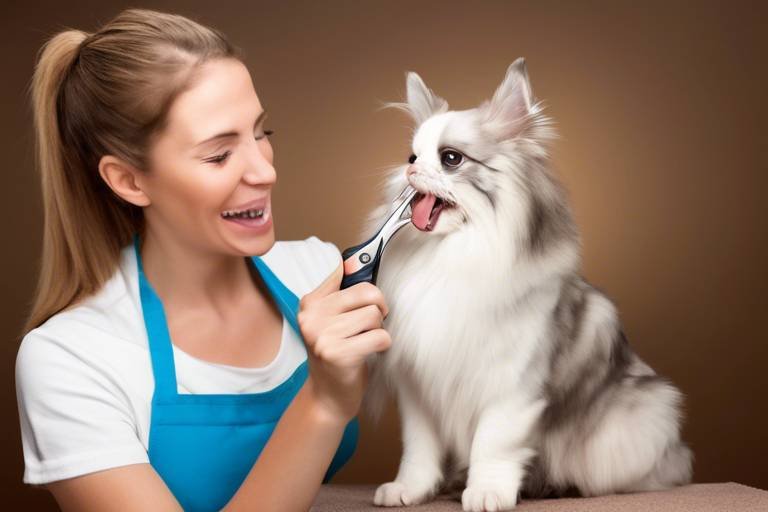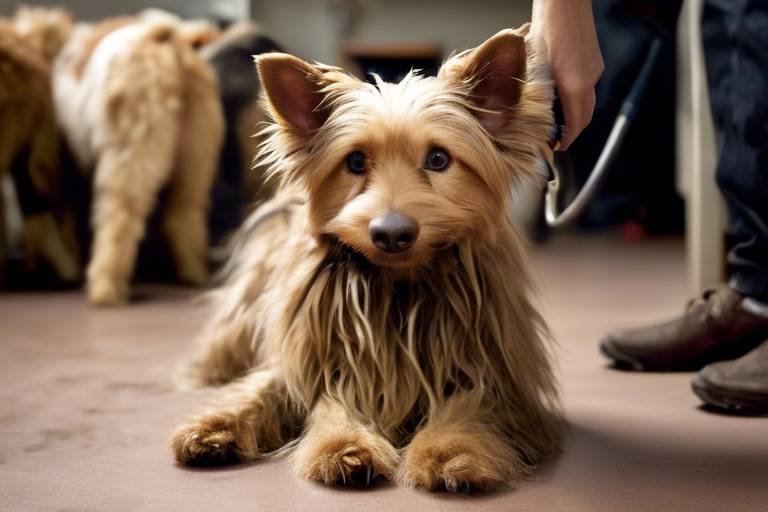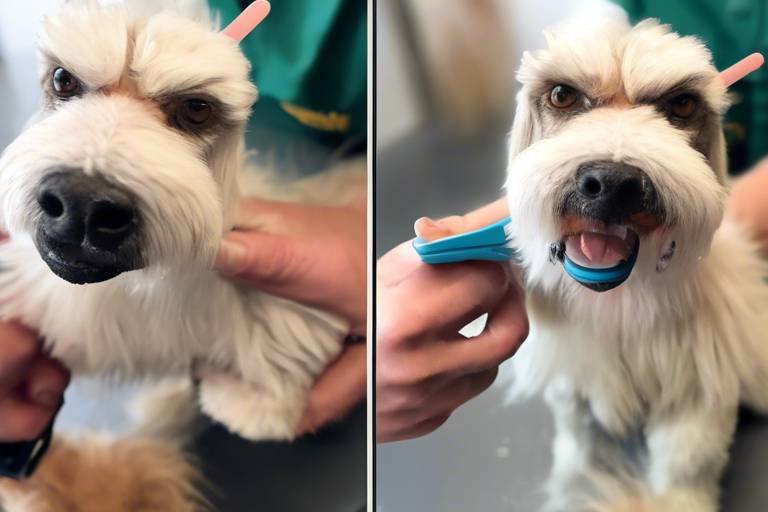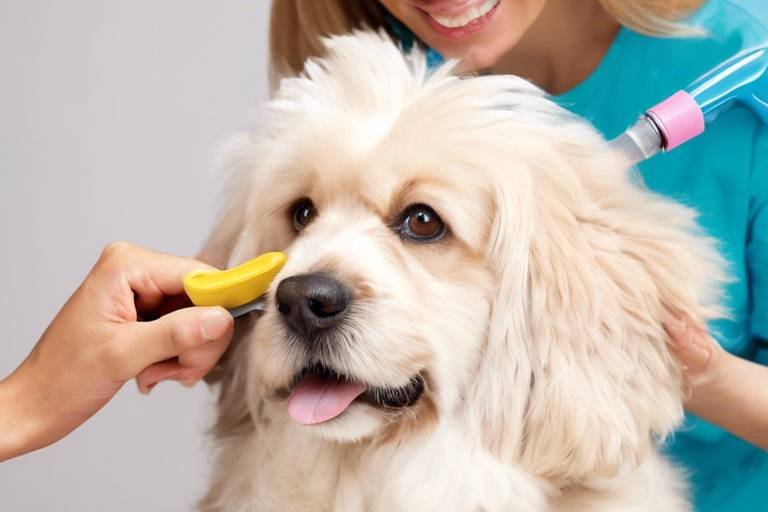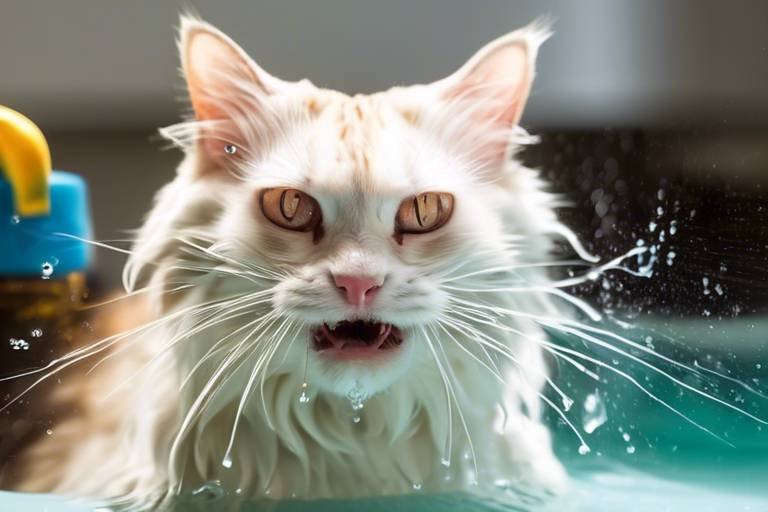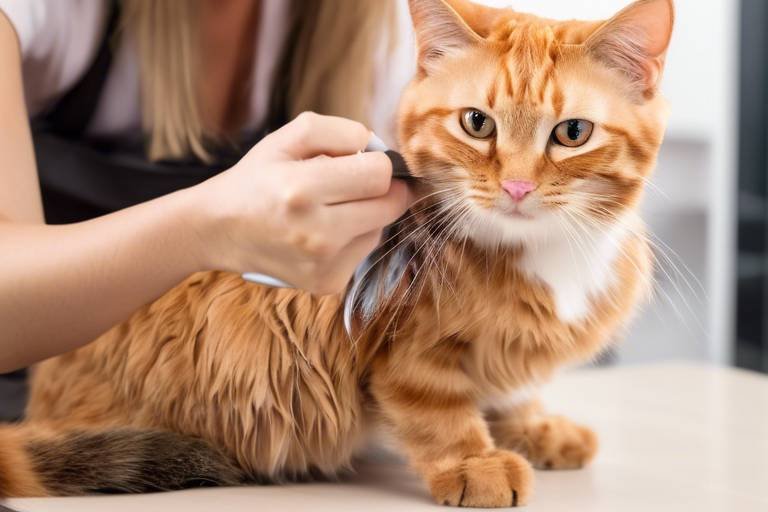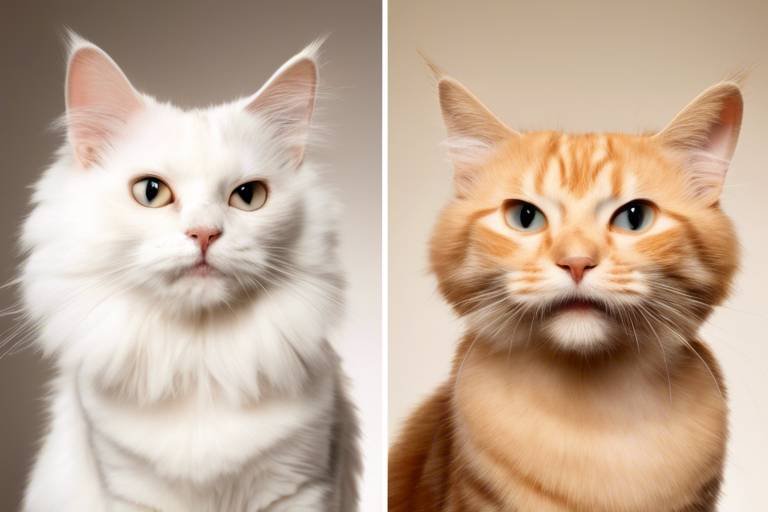The Benefits of Grooming for Pet Weight Management
When it comes to our beloved furry friends, we often think about their nutrition and exercise as the primary factors in maintaining a healthy weight. However, one aspect that is frequently overlooked is grooming. You might be surprised to learn that regular grooming can play a pivotal role in managing your pet's weight effectively. Not only does grooming keep your pet looking sharp and clean, but it also provides a plethora of physical, emotional, and health benefits that contribute to their overall well-being. In this article, we'll dive deep into how grooming can enhance your pet's weight management journey, making it a fun and engaging experience for both of you.
Have you ever thought about how grooming sessions can serve as a barometer for your pet's health? Regular grooming helps you monitor your pet's body condition, allowing you to notice any fluctuations in weight. This awareness can encourage you to adopt healthier habits, both for your pet and yourself. For instance, during grooming, you may realize that your pet has gained a few extra pounds. This realization can prompt you to adjust their diet or increase their activity level, leading to improved weight management and overall health. In essence, grooming is not just about aesthetics; it's about fostering a healthier lifestyle for your furry companion.
Grooming sessions can be more than just a chore; they can be an excellent opportunity to encourage physical activity in your pet. Engaging in grooming can lead to increased playtime and exercise, essential components of maintaining a healthy weight. Think of it this way: when you brush your pet, you’re not just removing loose fur; you’re also stimulating their muscles and promoting a more active lifestyle. The more engaged your pet is during grooming, the more likely they are to be active afterwards.
Different grooming activities can stimulate movement and engagement. Here are a few examples:
- Brushing: This not only removes loose fur but also provides an opportunity for interactive play.
- Bathing: A fun and engaging experience that keeps pets clean while encouraging movement.
- Nail Trimming: Essential for maintaining mobility and comfort, preventing pain from overgrown nails.
Brushing your pet can be a delightful experience that goes beyond just grooming. It creates a moment of bonding, allowing you to engage with your pet while keeping them active. As you brush, you might find that your pet starts to playfully nudge you or chase the brush, turning a simple grooming session into a mini playdate. This interactive element not only strengthens your bond but also keeps your pet moving, which is crucial for weight management.
Bathing is another grooming activity that can double as a workout for your pet. Pets often enjoy splashing around in water, and this can lead to increased movement. Whether it’s a playful shake-off after a bath or a spirited romp in the tub, bathing sessions can contribute to their overall exercise routine while keeping them clean and healthy.
Don’t underestimate the importance of regular nail trimming! Overgrown nails can lead to discomfort and pain, making your pet less likely to engage in physical activities. Keeping their nails trimmed not only ensures their comfort but also promotes better mobility. A pet that feels good is more likely to be active, which is essential for effective weight management.
Grooming is not just about the physical aspects; it also plays a significant role in your pet's emotional well-being. Regular grooming promotes a sense of security and comfort in pets. This emotional stability can reduce stress-related eating, which is often a contributor to unhealthy weight gain. When your pet feels calm and secure, they are less likely to turn to food for comfort, making it easier to maintain a healthy weight.
Think of grooming as a soothing ritual for your pet. It can serve as a calming activity, helping to alleviate anxiety and stress. Just like a warm bath can relax us after a long day, grooming can have a similar effect on our pets. A relaxed pet is more likely to engage in healthy activities rather than resorting to stress eating.
Regular grooming fosters trust between you and your pet. When your pet trusts you, they are more likely to engage in physical activities with confidence. This confidence can translate to a more active lifestyle, ultimately aiding in weight management. A pet that feels secure and loved is more inclined to play, run, and explore their environment.
Grooming plays a crucial role in maintaining your pet's overall health, which directly impacts their weight management efforts. A healthy pet is a happy pet, and regular grooming helps prevent obesity-related health issues that can arise from neglecting their grooming needs.
A healthy coat and skin are vital for your pet's well-being. Regular grooming helps identify skin issues early, preventing conditions that could hinder mobility and weight management. Healthy skin and fur not only make your pet look good but also ensure they feel good, encouraging them to be more active.
During grooming, you have the perfect opportunity to spot changes in your pet's body, such as lumps or unusual weight gain. This proactive approach allows for timely veterinary consultations and better weight management strategies. Remember, early detection can make all the difference in your pet's health!
Establishing a consistent grooming routine can significantly impact your pet's weight management efforts. By making grooming a regular part of your pet's life, you can easily monitor their health and encourage them to stay active.
Determining the right frequency and techniques for grooming is essential for meeting your pet's specific needs. Every pet is unique, and understanding their grooming requirements can promote effective weight management practices.
Finally, integrating playtime into grooming sessions can enhance the experience for your pet. By making grooming enjoyable, you not only keep your pet clean but also promote their physical activity and weight management goals. Who knew grooming could be such a fun bonding experience?
1. How often should I groom my pet?
The frequency of grooming depends on your pet's breed, coat type, and activity level. Generally, dogs with longer coats may require grooming every few days, while short-haired breeds may only need grooming once a week.
2. Can grooming help with my pet's anxiety?
Yes! Regular grooming can provide a calming effect on pets, helping to alleviate anxiety and stress. It can also strengthen the bond between you and your pet, increasing their sense of security.
3. What are the signs that my pet needs to be groomed?
Signs that your pet needs grooming include excessive shedding, matting of fur, bad odor, or visible dirt. If you notice any changes in their coat or skin, it's time for a grooming session!

Understanding the Link Between Grooming and Weight
When we think about grooming our beloved pets, we often focus on the aesthetic aspects—making them look good and smell fresh. However, there’s a deeper connection between grooming and weight management that many pet owners might overlook. Regular grooming sessions serve as an excellent opportunity for pet owners to monitor their pet's body condition. During these sessions, you can easily spot any changes in your pet's weight, which is crucial for maintaining their health.
Consider this: grooming isn’t just about the fur; it’s about forming a routine that promotes awareness. When you groom your pet regularly, you become more attuned to their physical state. This awareness can lead to proactive measures in managing their weight. For instance, if you notice that your pet is gaining weight, you can adjust their diet or increase their activity level. This simple practice can significantly contribute to healthier habits and ultimately better weight management.
Moreover, grooming can encourage a more active lifestyle for your pet. Think of grooming as a gateway to playtime! When you brush your pet, you’re not only removing loose fur but also engaging them in a fun activity that can lead to increased movement. This is especially important for pets that may not get enough exercise on their own. By incorporating play into grooming, you’re not just keeping them clean; you’re also promoting their overall health and well-being.
In addition, grooming can help create a bond between you and your pet. This connection fosters a sense of security, making your pet more open to engaging in physical activities. When pets feel secure and comfortable, they’re more likely to participate in play, which is essential for maintaining a healthy weight. The emotional benefits of grooming cannot be overstated; it’s a two-way street that enhances both the pet's and the owner's quality of life.
In summary, grooming goes beyond mere aesthetics. It’s a multifaceted tool that can help in monitoring weight, encouraging physical activity, and building a stronger bond between you and your furry friend. By understanding this link, you can take proactive steps toward ensuring your pet remains healthy and happy.

The Role of Grooming in Physical Activity
When we think about grooming our pets, we often focus on aesthetics—making them look good and smell fresh. However, grooming plays a much deeper role in promoting physical activity for our furry companions. Regular grooming sessions can transform into an exciting opportunity for pets to engage in movement, which is essential for maintaining a healthy weight. Just like how a good workout can energize us, grooming can stimulate our pets' desire to play and exercise.
During grooming, whether it's brushing, bathing, or nail trimming, pets are often encouraged to move around more than they typically would. For instance, when you brush your dog, they might wiggle around, chasing the brush or playfully trying to nibble at the bristles. This playful interaction not only helps to remove loose fur but also acts as a form of exercise that can contribute to their overall fitness. The simple act of grooming can create an engaging environment that inspires pets to be active.
Moreover, grooming can lead to increased playtime. After a good brushing session, many pets feel invigorated and ready to romp around. You might notice your cat darting around the house or your dog fetching their favorite toy. This burst of energy is a fantastic way to integrate physical activity into your pet's routine without them even realizing it. By turning grooming into a fun and interactive session, you're helping your pet stay active while also strengthening the bond between you.
Different types of grooming activities can stimulate movement and engagement in pets. Here are a few examples:
- Brushing: As mentioned, brushing can lead to playful interactions that encourage pets to move.
- Bathing: The process of bathing can be an exciting experience, prompting pets to shake off water and play in the tub.
- Nail Trimming: While this may not seem like a physical activity, the process of holding and positioning your pet can encourage them to shift and move.
Each of these grooming activities not only keeps your pet clean and healthy but also serves as a catalyst for increased movement. Think of grooming as a warm-up session that gets your pet ready for playtime. By incorporating these activities into your routine, you can help your pet develop a more active lifestyle, which is crucial for effective weight management.
In essence, grooming is much more than a chore; it’s an opportunity to engage your pet in physical activity. So, the next time you pick up that brush or prepare for bath time, remember that you’re not just beautifying your pet—you’re also giving them a chance to move, play, and stay healthy!
Q: How often should I groom my pet for optimal physical activity benefits?
A: The frequency of grooming depends on your pet's breed and coat type. Generally, regular grooming sessions once a week can help maintain their coat and encourage movement.
Q: Can grooming help with my pet's anxiety?
A: Yes! Grooming can be a calming experience for pets, helping to reduce anxiety and stress, which can lead to healthier weight management.
Q: What are some signs that my pet enjoys grooming?
A: If your pet relaxes during grooming, wags their tail, or engages playfully, these are good indicators that they enjoy the experience.
Types of Grooming Activities
When it comes to grooming your furry friend, there’s a whole world of activities that not only keep them looking fabulous but also encourage a more active lifestyle. Think of grooming as a fun workout session for your pet! It’s not just about aesthetics; it’s about engaging your pet in a way that promotes both physical and emotional health. Here are some key grooming activities that can stimulate movement and engagement:
Brushing is one of the most common grooming activities, and it serves multiple purposes. Not only does it help to remove loose fur and prevent matting, but it also provides a wonderful opportunity for interactive play. Imagine this: you’re sitting on the floor, brushing your pet while they wiggle and squirm with delight. This kind of bonding not only strengthens your relationship but also keeps them active. Plus, a good brushing session can turn into a playful chase when you toss some of that loose fur around!
Next up is bathing. Yes, bath time can be a playful adventure! Many pets love splashing around in water, and bathing can become a delightful experience that encourages them to move around. It’s like a mini swimming session right in your tub! During bath time, you can also incorporate fun toys or treats to make it even more engaging. Just remember to use pet-friendly shampoos to keep their skin and coat healthy.
Don’t forget about nail trimming. While it might not sound like the most exciting grooming activity, regular nail trims are crucial for maintaining your pet's mobility and comfort. Overgrown nails can cause pain and discomfort, leading to decreased activity levels. You can make nail trimming a more positive experience by using treats or praise, turning it into a rewarding session rather than a chore. This way, your pet will associate nail trimming with something enjoyable, making future sessions easier.
Lastly, let’s talk about ear cleaning and teeth brushing. These grooming activities not only contribute to your pet's hygiene but can also lead to some playful interactions. For instance, while cleaning their ears, you can gently massage their head, which many pets find soothing. Similarly, brushing their teeth can be a fun bonding moment. Use flavored toothpaste designed for pets to make it a treat rather than a task. This not only keeps their mouth healthy but also encourages them to engage with you during the process.
In summary, grooming is much more than a routine chore; it’s a series of activities that can enhance your pet’s lifestyle. By incorporating these grooming activities into your regular routine, you can promote physical activity, strengthen your bond, and keep your pet happy and healthy. So next time you reach for the brush or the shampoo, remember that you’re not just grooming; you’re also engaging your pet in a fun and active way!
- How often should I groom my pet? The frequency of grooming depends on your pet's breed and coat type. Generally, long-haired breeds require more frequent grooming than short-haired ones.
- Can grooming help with shedding? Yes! Regular grooming can significantly reduce shedding by removing loose fur and preventing matting.
- What tools do I need for grooming? Basic grooming tools include a brush, comb, nail clippers, and pet-friendly shampoo. Specific breeds may require specialized tools.
- Is grooming stressful for pets? Some pets may find grooming stressful at first. However, with patience and positive reinforcement, it can become an enjoyable experience.
Brushing for Bonding and Activity
When it comes to grooming your pet, brushing is more than just a task—it's an opportunity for bonding and enhancing your pet's activity levels. Imagine this: you sit down with your furry friend, brush in hand, and as you gently glide the brush through their coat, you can almost see the stress of the day melt away. This simple act not only helps to remove loose fur and dirt but also creates a special moment between you and your pet. It's like a mini spa day that encourages them to engage and interact.
Brushing serves as a perfect excuse to spend quality time together. As you brush, your pet is likely to respond with playful nudges or gentle purring, showing that they appreciate your attention. This interactive experience can lead to spontaneous play sessions, where your pet may leap around, chasing the brush or rolling over for more scratches. Such moments are crucial for keeping your pet active, especially for those who may not get enough exercise throughout the day.
Moreover, regular brushing can be a great way to instill a routine that your pet can look forward to. Here are a few benefits of incorporating brushing into your grooming sessions:
- Encourages Physical Activity: The excitement of grooming can lead to increased playfulness, making your pet more active.
- Strengthens Your Bond: The close contact and mutual enjoyment of brushing foster a stronger relationship.
- Promotes Relaxation: The rhythmic motion of brushing can soothe your pet, making them feel secure and loved.
In essence, brushing is not just about maintaining a tidy coat; it's about creating a joyful experience that benefits both you and your pet. So, the next time you pick up that brush, remember that you're not just grooming—you're enhancing your pet's well-being and encouraging a more active lifestyle.
Q1: How often should I brush my pet?
A1: The frequency of brushing depends on your pet's coat type. Long-haired breeds may require daily brushing, while short-haired breeds might need it once a week.
Q2: Can brushing help with shedding?
A2: Yes! Regular brushing helps remove loose fur and can significantly reduce shedding around your home.
Q3: What should I do if my pet doesn't like being brushed?
A3: Start slow! Use a soft brush and gradually introduce the process, rewarding your pet with treats and praise to create a positive experience.
Bathing and Its Benefits
Bathing your pet is more than just a routine chore; it's a vital part of their overall health and well-being. Imagine this: your furry friend, splashing around in warm water, enjoying every moment while you scrub away dirt and grime. It's not just about cleanliness; it's an engaging experience that can significantly contribute to your pet's physical activity and emotional health. Regular baths can stimulate movement, encouraging your pet to shake, jump, and play in the water, which is an excellent way to incorporate exercise into their routine.
Moreover, bathing sessions can become a bonding experience between you and your pet. The gentle lathering of shampoo and the soothing rinse can help your pet feel relaxed and secure, making them more open to physical activity afterward. This is especially important because a relaxed pet is more likely to engage in play, which helps maintain a healthy weight. Just think of bathing as a mini spa day for your pet, where they not only get clean but also feel rejuvenated and ready to romp around!
Another significant benefit of regular bathing is the opportunity to check your pet's skin and coat for any abnormalities. When you're lathering up your pet, you can easily spot issues like dry patches, lumps, or irritations that might otherwise go unnoticed. This early detection can prevent potential health problems, allowing you to consult your veterinarian promptly. In essence, bathing serves as a dual-purpose activity: it keeps your pet clean and provides a health check-up.
Now, you might wonder how often you should bathe your pet. This can vary based on the breed, coat type, and lifestyle of your pet. For example, dogs with longer fur may require more frequent baths compared to short-haired breeds. Here’s a quick reference table to help guide you:
| Pet Type | Recommended Bathing Frequency |
|---|---|
| Short-haired Dogs | Every 2-3 months |
| Long-haired Dogs | Every month |
| Cats | Every 3-6 months |
| Active Dogs (e.g., those who play outside often) | As needed, usually every 4-6 weeks |
In conclusion, bathing is not merely a hygiene practice; it’s a holistic approach to your pet’s health and happiness. By making bathing a fun and engaging experience, you not only keep your pet clean but also promote their physical activity and emotional well-being. So, the next time you reach for the shampoo, remember that you’re doing much more than just washing away dirt; you’re contributing to a healthier, happier, and more active pet!
- How often should I bathe my pet? It depends on the breed and lifestyle of your pet. Generally, short-haired dogs can be bathed every 2-3 months, while long-haired dogs may need a bath every month.
- Can I use human shampoo on my pet? No, human shampoos can be too harsh for pets. Always use a shampoo specifically formulated for animals.
- What if my pet hates baths? Try to make the experience enjoyable by using treats and praise. You can also consider using a gentle spray or sponge bath if they are particularly resistant.
- Are there any benefits to bathing my pet beyond cleanliness? Yes! Bathing can promote physical activity, provide an opportunity for health checks, and strengthen the bond between you and your pet.
Nail Trimming and Mobility
Nail trimming is often an overlooked aspect of pet grooming, yet it plays a crucial role in maintaining your pet's overall mobility and comfort. Imagine trying to walk in shoes that are two sizes too small; it would be uncomfortable, right? The same goes for our furry friends when their nails grow too long. Overgrown nails can lead to a variety of issues, including pain, difficulty walking, and even changes in their gait. This discomfort can discourage your pet from engaging in physical activities, which are essential for maintaining a healthy weight.
When nails are left untrimmed, they can curl and dig into the paw pads, causing significant pain and potential injury. This situation can create a vicious cycle: as your pet becomes less active due to discomfort, they may gain weight, leading to further health complications. Regular nail trimming not only prevents these issues but also promotes better mobility, allowing your pet to run, jump, and play freely. It’s like giving them a new lease on life!
Moreover, the nail trimming process can be an opportunity for bonding between you and your pet. Many pets enjoy the attention they receive during grooming sessions, and this can help them associate nail trimming with positive experiences. By establishing a routine that includes nail care, you’re not just maintaining their physical health but also fostering a trusting relationship, which can encourage your pet to be more active.
To ensure that your pet's nails are kept at a healthy length, consider the following tips:
- Frequency: Depending on your pet's activity level and the surfaces they walk on, nails may need to be trimmed every 2-4 weeks.
- Tools: Use proper nail clippers designed for pets. A file can also help smooth out any sharp edges after trimming.
- Positive Reinforcement: Reward your pet with treats or praise after a successful nail trimming session to make it a more enjoyable experience.
In conclusion, regular nail trimming is a small yet significant part of your pet's grooming routine that can greatly enhance their mobility and overall well-being. By keeping their nails in check, you’re not only preventing pain but also encouraging an active lifestyle that contributes to effective weight management.
- How often should I trim my pet's nails? It typically depends on your pet's activity level, but every 2-4 weeks is a good rule of thumb.
- What tools do I need for nail trimming? A good pair of pet nail clippers and a nail file are essential for a smooth trimming process.
- What if my pet is scared of nail trimming? Gradually introduce the process and use positive reinforcement to make it a more comfortable experience for them.

Emotional Well-being and Weight Management
When it comes to our furry friends, emotional well-being plays a significant role in their overall health, including weight management. Just like humans, pets can experience stress, anxiety, and even depression, all of which can lead to unhealthy eating habits and weight gain. Grooming is not just about aesthetics; it serves as a vital tool in promoting a sense of security and comfort for pets. By incorporating regular grooming sessions into your pet's routine, you're not only keeping them looking their best but also contributing to their emotional stability.
One of the most profound benefits of grooming is its ability to reduce stress. Imagine how soothing it feels to have a gentle brush glide over your skin; pets feel that too! Grooming can be a calming activity, allowing pets to relax and enjoy the moment. When pets feel calm, they are less likely to engage in stress-related eating, which can lead to weight gain. This is particularly important for pets that may be prone to anxiety. Regular grooming can help create a serene environment, allowing your pet to feel safe and secure.
Moreover, grooming fosters trust between pets and their owners. When pets associate grooming with positive experiences, they build confidence and become more willing to engage in physical activities. This newfound confidence can lead to increased playfulness, which is essential for maintaining a healthy weight. Think of grooming as a bonding experience; it’s a time when you can connect with your pet, reinforcing their trust in you. The more trust they have, the more likely they are to be active and engaged in their environment.
Additionally, the emotional benefits of grooming extend to owners as well. The act of grooming can be incredibly rewarding, as it strengthens the bond you share with your pet. This emotional connection can motivate you to be more active with your pet, whether it’s through playtime or outdoor activities. As you both enjoy these moments together, you’re not just improving your pet’s emotional health but also enhancing your own well-being. It’s a win-win situation!
In summary, the emotional well-being of your pet is intricately linked to their weight management. By incorporating regular grooming into your routine, you’re providing a foundation of trust, reducing stress, and creating opportunities for physical activity. So, the next time you pick up that brush or prepare for a bath, remember that you’re doing more than just keeping your pet clean—you’re nurturing their emotional health, which is essential for a happy, healthy life.
- How often should I groom my pet? The frequency of grooming depends on your pet's breed and coat type. Generally, long-haired breeds may require grooming several times a week, while short-haired breeds might need it less frequently.
- Can grooming help with my pet's anxiety? Yes! Regular grooming can provide a calming effect and help reduce anxiety in pets, making them feel more secure and relaxed.
- What are the signs that my pet needs grooming? If you notice mats in their fur, excessive shedding, or a dirty coat, it's time for a grooming session. Additionally, if your pet seems uncomfortable or irritable, grooming can help alleviate that discomfort.
- Is grooming only about aesthetics? No, grooming is essential for your pet's health and emotional well-being. It helps prevent skin issues, promotes bonding, and encourages physical activity.
Reducing Stress Through Grooming
Grooming is more than just a way to keep our pets looking their best; it's a vital practice that can significantly reduce stress in our furry friends. Just imagine how a gentle brush through your dog's fur can not only remove tangles but also act like a soothing massage. This simple act can create a calming atmosphere, transforming what might be a mundane chore into a cherished bonding experience. When pets are groomed regularly, they become accustomed to the process, which helps them feel more secure and relaxed.
Studies have shown that grooming can lower anxiety levels in pets. For example, the rhythmic motion of brushing can mimic the natural grooming behaviors that animals experience in the wild, promoting a sense of safety and comfort. This is especially important for pets that may have experienced trauma or stress in their past. By incorporating grooming into their routine, you can help them build a positive association with touch and attention, which can lead to a more balanced emotional state.
Furthermore, the act of grooming can serve as an effective distraction from stressors. When you focus on grooming, both you and your pet can take a break from the hustle and bustle of daily life. It provides a moment of tranquility, allowing your pet to unwind and enjoy the attention. This is particularly beneficial for pets that may be prone to anxiety during events such as thunderstorms or fireworks. A calming grooming session can redirect their focus and help them feel more at ease.
In addition to the emotional benefits, grooming also encourages a routine that can stabilize your pet’s overall well-being. Just like humans, pets thrive on consistency. A predictable grooming schedule can give them something to look forward to, reducing anxiety and promoting a sense of normalcy in their lives. For instance, you might establish a weekly grooming day, where your pet knows they will receive extra love and care. This routine can become a special time that both you and your pet cherish, fostering a deeper bond.
To maximize the stress-reducing benefits of grooming, consider incorporating a few techniques:
- Choose the Right Tools: Use brushes and combs that are appropriate for your pet's coat type to ensure comfort.
- Maintain a Calm Environment: Groom in a quiet space free from distractions to help your pet relax.
- Use Positive Reinforcement: Reward your pet with treats or praise during and after grooming sessions to create a positive association.
By making grooming a positive and enjoyable experience, you can significantly reduce your pet's stress levels, which in turn can help with weight management. A relaxed pet is more likely to engage in playful activities, making it easier for them to maintain a healthy weight. So, the next time you pick up that brush, remember: you’re not just grooming your pet; you’re also nurturing their emotional health.
Q: How often should I groom my pet?
A: The frequency of grooming depends on your pet's breed and coat type. Generally, long-haired breeds may require grooming several times a week, while short-haired breeds might only need it once a month.
Q: Can grooming help my pet lose weight?
A: While grooming itself doesn’t directly lead to weight loss, it encourages physical activity and bonding, which can promote a healthier lifestyle.
Q: What if my pet doesn't like grooming?
A: Start slow and make the experience positive. Use treats and praise, and consider consulting a professional groomer for help.
Q: Are there specific grooming tools I should use?
A: Yes, the right tools depend on your pet's coat type. Research or ask a vet for recommendations to ensure comfort and effectiveness.
Building Trust and Confidence
Building trust and confidence between you and your pet is one of the most rewarding aspects of grooming. Imagine your furry friend, once hesitant and anxious, now eagerly approaching you with a wagging tail or a gentle purr. This transformation is not just a dream; it’s a reality that grooming can help facilitate. When you engage in regular grooming sessions, you create a safe space for your pet, allowing them to feel secure and loved. This bond is crucial because it encourages your pet to be more open to physical activities, which is essential for weight management.
During grooming, you’re not just brushing fur or trimming nails; you’re also communicating with your pet. The gentle strokes of a brush or the soothing sound of water during a bath can be incredibly comforting. This tactile interaction promotes a sense of well-being and trust. Your pet learns to associate grooming with positive experiences, making them more likely to engage in play and exercise afterward. It’s like building a bridge of trust that leads to a healthier lifestyle.
Moreover, a confident pet is more likely to explore their environment, engage with toys, and participate in activities that promote physical fitness. When your pet trusts you, they are more willing to try new things, whether it’s a new toy or a new route on your daily walk. The confidence gained from regular grooming sessions spills over into their overall behavior, encouraging them to be active and playful. This is particularly important for pets that may be shy or reserved, as grooming can help them break out of their shell.
To further enhance this trust-building experience, consider the following tips during grooming sessions:
- Use Positive Reinforcement: Reward your pet with treats or praise during and after grooming to create a positive association.
- Be Gentle and Patient: Take your time, especially if your pet is anxious. A calm approach can make all the difference.
- Incorporate Play: Mix in playful interactions during grooming, such as using toys to keep the mood light and fun.
Ultimately, the bond you create through grooming not only enhances your pet’s confidence but also contributes significantly to their weight management journey. A confident, happy pet is more likely to engage in physical activities, leading to a healthier weight. So, the next time you grab that brush or nail clipper, remember that you’re not just grooming your pet; you’re nurturing a relationship built on trust and love.
- How often should I groom my pet?
It depends on the breed and coat type. Some pets may need grooming weekly, while others may require it less frequently. - Can grooming help with my pet's anxiety?
Yes! Regular grooming can create a calming routine that helps reduce anxiety and builds trust between you and your pet. - What are the best practices for grooming?
Always use appropriate tools, be gentle, and incorporate positive reinforcement to make grooming a pleasant experience. - Is it necessary to groom my pet if they have short fur?
Yes, grooming is still important for short-haired pets to remove loose hair and prevent skin issues.

Health Benefits of Regular Grooming
Regular grooming is not just about keeping your pet looking fabulous; it plays a crucial role in maintaining their overall health. When you think about grooming, you might picture brushing fur or trimming nails, but there's so much more beneath the surface. Grooming acts as a preventive measure that can help detect health issues before they become serious. Think of it as a routine check-up, but instead of a doctor's office, it's done right at home, in the comfort of your living room.
One of the most significant benefits of grooming is its impact on skin and coat health. A well-groomed pet has a shiny coat and healthy skin, which are indicators of overall well-being. Regular brushing helps remove dirt, debris, and dead hair, reducing the risk of skin irritations and infections. Additionally, it promotes blood circulation, which is essential for healthy skin and fur. When you groom your pet, you're not just making them look good; you're also ensuring their skin stays healthy and free from issues that could hinder their mobility and weight management.
Another vital aspect of grooming is the opportunity it provides for monitoring your pet's health. During grooming sessions, owners can easily spot changes in their pet's body, such as lumps, bumps, or unusual weight gain. This early detection can lead to timely veterinary consultations, which are crucial for effective weight management strategies. For instance, if you notice that your pet has gained weight, it might be a sign of an underlying health issue that needs addressing. By keeping a close eye on your pet’s body condition during grooming, you can stay ahead of potential problems.
Moreover, regular grooming can prevent obesity-related health issues. Pets that are groomed consistently are less likely to develop conditions like skin infections or matting, which can lead to decreased activity levels. When pets are uncomfortable due to skin issues, they may be less inclined to exercise, leading to weight gain. Thus, maintaining a regular grooming routine can help ensure that your pet remains active and engaged, contributing to their weight management efforts.
In addition to skin and coat health, grooming also provides an opportunity to check the health of your pet's ears and teeth. Regularly cleaning your pet's ears can prevent infections, while brushing their teeth can combat dental disease, which is a common issue in pets. Neglecting these areas can lead to pain and discomfort, which could discourage your pet from being active. A healthy pet is typically a more active pet, and grooming is a key part of that equation.
To sum it up, regular grooming is a multifaceted approach to maintaining your pet's health. It not only ensures that they look their best but also plays a vital role in preventing health issues that could affect their weight and overall well-being. So, the next time you pick up that brush or nail clippers, remember that you're doing more than just a chore; you're contributing to your pet's health and happiness.
- How often should I groom my pet? The frequency of grooming depends on your pet's breed and coat type. Long-haired pets may require grooming several times a week, while short-haired pets might only need it once a month.
- Can grooming help with my pet's anxiety? Yes, regular grooming can provide comfort and security to pets, reducing anxiety and stress levels.
- What tools do I need for grooming? Basic grooming tools include a brush, comb, nail clippers, and shampoo. The specific tools may vary based on your pet's needs.
Skin and Coat Health
When it comes to our furry friends, maintaining their is crucial for their overall well-being. Regular grooming not only keeps your pet looking fabulous but also plays a pivotal role in identifying potential health issues early on. Just think of grooming as a preventive health check-up that you can do right at home! By brushing and bathing your pet, you can help remove dirt, debris, and loose fur, which can otherwise lead to skin irritations or infections.
Moreover, grooming sessions provide an excellent opportunity to check for any unusual lumps, bumps, or changes in your pet's skin condition. Remember, early detection can be the key to effective treatment. For instance, if you notice any red patches or excessive scratching, these could be signs of allergies or parasites that need veterinary attention. As a pet owner, being proactive during grooming can lead to a happier, healthier pet.
Additionally, a well-groomed coat can significantly impact your pet's comfort level. For pets with long or thick fur, regular grooming can prevent painful matting that can restrict movement and cause discomfort. Just like humans, pets can feel a lot better when their skin is clean and their coat is free from tangles. And let's not forget about the emotional benefits—your pet will feel more relaxed and confident when they are comfortable in their own skin!
To give you a better understanding of how grooming affects skin and coat health, here’s a quick overview:
| Grooming Activity | Benefits |
|---|---|
| Brushing | Removes loose fur, stimulates skin oils, and promotes blood circulation. |
| Bathing | Cleans the coat, removes allergens, and can soothe skin irritations. |
| Nail Trimming | Prevents overgrown nails that can cause discomfort and affect mobility. |
In conclusion, regular grooming is not just about aesthetics; it’s a vital aspect of your pet's health management. By keeping a close eye on your pet's skin and coat during grooming sessions, you can ensure they stay healthy, comfortable, and ready for playtime!
- How often should I groom my pet? It depends on the breed and coat type, but generally, regular grooming every few weeks is recommended.
- Can grooming help with shedding? Yes, regular grooming can significantly reduce shedding by removing loose fur before it ends up on your furniture.
- What products should I use for grooming? Use pet-specific shampoos and conditioners that are gentle on their skin. Always consult your vet for recommendations.
- Is grooming stressful for pets? It can be, especially if they are not used to it. Gradually introducing grooming can help them become more comfortable.
Monitoring Health Through Grooming
When it comes to our furry companions, grooming is about so much more than just keeping them looking sharp. It’s a golden opportunity to monitor their health closely. Think of grooming sessions as mini check-ups that you can perform right at home. During these times, you can observe your pet for any changes that might indicate health issues. For example, are their eyes bright and clear? Is their coat shiny and free from bald patches or excessive shedding? These details can be red flags, signaling that something might be off.
Regular grooming allows you to keep a close eye on your pet's body condition. You might notice subtle changes in their weight that could easily go overlooked in the hustle and bustle of daily life. If your pet is gaining weight, you might see a shift in their belly area or a decrease in their waistline. Conversely, if they’re losing weight, you may notice their ribs becoming more prominent. These observations are crucial because they can lead to early detection of potential health problems, such as obesity or other underlying issues.
Additionally, grooming provides an excellent opportunity to check for lumps, bumps, or unusual skin conditions. While brushing your pet, you can feel for any abnormalities that might require a vet’s attention. If you find something concerning, you can schedule a vet visit sooner rather than later, potentially catching issues before they escalate. This proactive approach not only keeps your pet healthier but can also save you from costly treatments down the road.
Furthermore, don’t underestimate the importance of the bond that develops during grooming. This time spent together can lead to greater trust, making it easier for your pet to accept handling and examinations in the future. The more comfortable they are with being touched and examined, the more likely you are to notice changes in their health. Remember, your hands are your best tool for monitoring your pet’s well-being.
In summary, grooming is a multifaceted activity that goes beyond aesthetics. It’s a vital part of a pet's healthcare routine, enabling owners to keep tabs on their furry friends' health and weight. By incorporating regular grooming into your routine, you’re not just pampering your pet; you’re actively participating in their overall health management.
- How often should I groom my pet? The frequency depends on your pet's breed, coat type, and activity level. Generally, regular grooming every few weeks is beneficial.
- What tools do I need for grooming? Basic grooming tools include a brush, comb, nail clippers, and shampoo. Specific breeds may require specialized tools.
- Can grooming help with my pet's anxiety? Yes! Regular grooming can create a calming routine for pets, helping to reduce their anxiety levels.
- What signs should I look for during grooming? Look for changes in weight, skin condition, lumps, or unusual behaviors that could indicate health issues.

Creating a Grooming Routine
Establishing a consistent grooming routine for your pet is not just about keeping them looking good; it’s a vital part of their overall health and weight management strategy. Think of grooming as a regular check-up that you can do at home, allowing you to monitor your pet's body condition and health while also encouraging them to stay active. The key is to find a routine that works for both you and your furry friend, making it a fun and rewarding experience.
First, consider the specific needs of your pet. Different breeds have varying grooming requirements, from short-haired cats that need minimal upkeep to long-haired dogs that require frequent brushing. It’s essential to tailor your grooming schedule based on these needs. For example, a golden retriever may need brushing several times a week to prevent matting, while a bulldog might only need a quick wipe down. Understanding these differences can help you create a more effective grooming routine.
Next, think about the frequency of grooming sessions. A good rule of thumb is to aim for at least once a week, but this can vary based on your pet's activity level and coat type. Regular grooming not only helps maintain a healthy coat but also provides an opportunity to check for any unusual changes in your pet’s body, such as lumps or skin irritations. Here’s a quick overview of how often different types of grooming should be done:
| Type of Grooming | Recommended Frequency |
|---|---|
| Brushing | 2-3 times a week for long-haired breeds; weekly for short-haired breeds |
| Bathing | Every 4-6 weeks, depending on activity level |
| Nail Trimming | Every 3-4 weeks |
Incorporating play into your grooming sessions can also enhance the experience. Instead of viewing grooming as a chore, turn it into a fun activity. For instance, while brushing your pet, you can use treats to reward them for their cooperation, or even incorporate a few minutes of playtime with their favorite toy in between grooming tasks. This not only makes the process enjoyable but also encourages your pet to associate grooming with positive experiences.
Finally, make sure to be consistent with your grooming schedule. Just like any routine, consistency is key to reaping the benefits. Setting a specific day and time each week for grooming can help you stay on track. Remember, the more you groom your pet, the more comfortable they’ll become with the process, which can lead to a stronger bond between you and your furry companion. Embrace the opportunity to connect with your pet during grooming sessions, and you’ll find that it becomes a cherished part of your routine.
- How often should I groom my pet? - It depends on the breed, but generally, once a week is a good starting point.
- What tools do I need for grooming? - Basic tools include a brush, nail clippers, and shampoo suitable for your pet's coat type.
- Can grooming help with my pet's anxiety? - Yes, regular grooming can provide comfort and reduce stress, helping to alleviate anxiety.
- What if my pet doesn’t like grooming? - Start slow, use treats, and make it a positive experience to help them adjust.
Frequency and Techniques
When it comes to grooming your pet, establishing the right frequency is crucial for both their health and weight management. Just like us, pets thrive on routine, and regular grooming sessions can help keep them in tip-top shape. Generally, the frequency of grooming depends on your pet's breed, coat type, and activity level. For instance, long-haired breeds might require grooming every few days to prevent matting, while short-haired pets might only need grooming once a week. But remember, grooming isn't just about aesthetics; it’s a golden opportunity to check in on their health and to promote physical activity.
To create an effective grooming routine, consider incorporating a variety of techniques that cater to your pet's specific needs. Here are some key techniques to keep in mind:
- Brushing: Regular brushing not only helps to remove loose fur but also stimulates blood circulation and distributes natural oils, promoting a healthy coat. Aim to brush your pet at least once a week, or more frequently if they have a thicker coat.
- Bathing: Bathing should be done as needed, typically every month or so, depending on your pet's lifestyle. Use pet-friendly shampoos to keep their skin healthy and avoid over-bathing, which can strip natural oils.
- Nail Trimming: Nail trimming is essential for your pet's comfort and mobility. Ideally, you should trim their nails every 3-4 weeks, but keep an eye on their activity level—if they’re active outdoors, they might wear them down naturally.
Integrating play into grooming sessions can also make the experience enjoyable. For example, have a toy nearby to encourage your pet to engage in some movement while you brush them. This not only makes grooming fun but also helps in burning off some extra calories, contributing to their weight management efforts. Remember, the goal is to make grooming a positive experience that your pet looks forward to, rather than a chore they dread.
In summary, establishing a consistent grooming routine tailored to your pet's needs is key to effective weight management. By paying attention to the frequency of grooming and employing various techniques, you're not only keeping your pet looking great but also ensuring they stay healthy and active!
- How often should I groom my pet? It depends on the breed and coat type. Generally, long-haired pets require more frequent grooming than short-haired ones.
- Can grooming help with my pet's weight management? Absolutely! Regular grooming encourages physical activity and helps monitor your pet's health, contributing to effective weight management.
- What tools do I need for grooming? Basic grooming tools include brushes, combs, nail clippers, and pet-friendly shampoos. Choose tools based on your pet's specific grooming needs.
Incorporating Play into Grooming
When it comes to grooming your pet, why not turn it into a fun-filled playtime? Incorporating play into grooming sessions can transform what might feel like a chore into an enjoyable bonding experience for both you and your furry friend. Imagine this: while you're brushing your pet’s coat, you toss a toy or engage them in a little game of hide-and-seek with their favorite treats. This not only keeps them entertained but also encourages movement, which is essential for maintaining a healthy weight.
One effective way to incorporate play is by using interactive toys during grooming. For instance, you can use a treat-dispensing toy that rewards your pet for staying calm and still while you groom them. This creates a positive association with grooming, making your pet more likely to look forward to these sessions in the future. Additionally, you can set up a mini agility course with obstacles that your pet has to navigate before or after grooming. This not only helps burn off some energy but also reinforces their training and keeps them agile.
Moreover, consider timing your grooming sessions around playdates with other pets. After a fun romp with their pals, your pet might be more inclined to cooperate during grooming, as they’ll be in a relaxed state. You could also introduce short, playful breaks during grooming. For example, after brushing one side, take a moment to toss a ball or play tug-of-war with a rope toy. This not only breaks the monotony but also keeps their spirits high and encourages a more active lifestyle.
In summary, incorporating play into grooming is a fantastic way to enhance your pet's experience while promoting their physical health. By making grooming sessions playful and engaging, you're not just caring for their coat and nails but also nurturing their emotional well-being and encouraging a healthier lifestyle. So next time you grab the brush, think about how you can turn it into a fun activity that both you and your pet will love!
- How often should I groom my pet? The frequency of grooming depends on your pet's breed and coat type. Generally, long-haired breeds require more frequent grooming than short-haired ones.
- Can grooming help with my pet's anxiety? Yes, regular grooming can provide comfort and reduce anxiety in pets, making them feel secure and relaxed.
- What are some signs that my pet needs grooming? Look for excessive shedding, mats in their fur, or overgrown nails as indicators that it's time for grooming.
- How can I make grooming more enjoyable for my pet? Incorporate playtime, use treats as rewards, and keep the sessions short and positive to make grooming a fun experience.
Frequently Asked Questions
- How does grooming help with my pet's weight management?
Grooming plays a vital role in weight management by allowing you to monitor your pet's body condition regularly. This awareness can prompt you to make healthier lifestyle choices for your pet, encouraging more physical activity and better eating habits.
- What types of grooming activities can promote physical activity?
Activities like brushing, bathing, and nail trimming can stimulate movement in your pet. For example, brushing can turn into a playful interaction, while bathing can encourage your pet to move around more, contributing to their exercise routine.
- Can grooming reduce my pet's stress levels?
Absolutely! Grooming can be a calming experience for pets, which helps alleviate anxiety. Less stress can lead to healthier eating habits, reducing the risk of stress-related weight gain.
- How often should I groom my pet?
The frequency of grooming depends on your pet's breed, coat type, and individual needs. Establishing a consistent grooming routine—whether it’s weekly or bi-weekly—can significantly aid in monitoring their health and managing their weight.
- What are the health benefits of regular grooming?
Regular grooming helps maintain your pet's skin and coat health, allowing you to spot potential health issues early. This proactive approach can prevent obesity-related conditions and keep your pet feeling great.
- Can I incorporate playtime into grooming sessions?
Definitely! Integrating play into grooming can make the experience enjoyable for your pet. This not only helps keep them active but also strengthens the bond between you and your furry friend.

